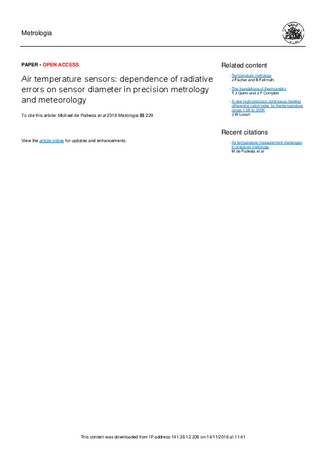In both meteorological and metrological applications, it is well known that air temperature sensors are susceptible to radiative errors. However, it is not widely known that the radiative error measured by an air temperature sensor in flowing air depends upon the sensor diameter, with smaller sensors reporting values closer to true air temperature. This is not a transient effect related to sensor heat capacity, but a fluid-dynamical effect arising from heat and mass flow in cylindrical geometries. This result has been known historically and is in meteorology text books. However, its significance does not appear to be widely appreciated and, as a consequence, air temperature can be—and probably is being—widely mis-estimated.
In this paper, we first review prior descriptions of the 'sensor size' effect from the metrological and meteorological literature. We develop a heat transfer model to describe the process for cylindrical sensors, and evaluate the predicted temperature error for a range of sensor sizes and air speeds. We compare these predictions with published predictions and measurements. We report measurements demonstrating this effect in two laboratories at NPL in which the air flow and temperature are exceptionally closely controlled. The results are consistent with the heat-transfer model, and show that the air temperature error is proportional to the square root of the sensor diameter and that, even under good laboratory conditions, it can exceed 0.1 °C for a 6 mm diameter sensor.
We then consider the implications of this result. In metrological applications, errors of the order of 0.1 °C are significant, representing limiting uncertainties in dimensional and mass measurements. In meteorological applications, radiative errors can easily be much larger. But in both cases, an understanding of the diameter dependence allows assessment and correction of the radiative error using a multi-sensor technique.

